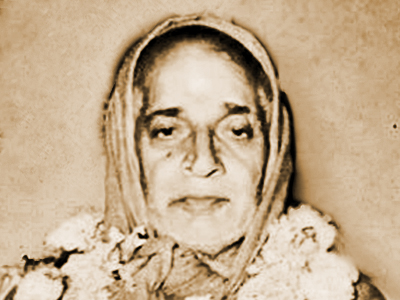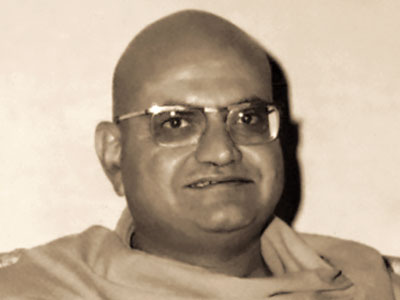Vedic monks take up the challenge of sublime erudition by delivering profoundly meaningful discourses on Sanskrit-based spiritual philosophy and wisdom teachings. Discoursing in Hindi based on extant literature of Vedic Sanskrit and Classical Sanskrit scriptures has been an established tradition in North India. Ardent listeners throng to these public fellowships and remain spellbound during the thematic presentation of philosophical nuances and related historical ethos. The depth of spiritual relevance and the unraveling of the metaphorical significance make it inspiring and self-empowering to seekers and devotees alike. This is verily a classical style of teaching that is replete with spiraling logic and a commentary which is fortified with references from other cardinal philosophies.
Discourses

Three Renowned Pontiff Monks
The following selection of discourses feature three renowned pontiff monks who hail from the same root monastic and Sanskrit lineages of our monastic council. The goal of this curriculum is to present discourses that are borne out of realization gained from deep contemplation on the Sanskrit texts and piercing monastic inquiry. These discourses invoke intricate and precise interpretation of the original Sanskrit scriptural compositions. The style and method of explanation evoke an experience of reflective contemplation and mental clarity while developing a deeper understanding of profound tenets of truth. Even though somewhat limited to the audience who know the Hindi language, the discourses help develop unlimited spiritual perception in the listener. It is obvious how listening to a traditional style of discourse in Hindi lends to unique insights into the context.

Selections
The selections are based on recordings which are available without corruption and are reasonably complete. These recordings are slowly and surely getting cleaned for posterity, and will be periodically re-uploaded for a better listening experience. Until the audio cleaning and a full content review is complete, the current digital library is made available in the interim. Even with minor inadequacies of audio noise the lectures reflecting an integral learning approach are captivating to the listener. These free recordings are also spread over diverse web resources, but are available here in one section. Any inquiry or comment about the content selection from our monastic network of resources may be addressed by writing only, to HH Swami Sharadananda at Vedanidhi in Varanasi, India.
Vedanidhi
(Vedic Heritage Research Foundation)
B-1/116A, Plot 50
Dumrao Bagh, Post Assi
Varanasi – 221005, India

His Holiness Swami Hariharananda Saraswati
India’s sensational and stunning monastic Sanskritist and adept of Vedic dharma, HH Swami Hariharananda Saraswati was born in 1907 in Pratapgarh, Uttar Pradesh, India. He was also popularly known as Karapatri Swami because he would eat only what would fit in his palms when used as a bowl. After three years of meditative penance in icy caves of the Himalayan Mountains he decided to take monastic initiation from the renowned Sanakaracharya of Jyoti Maṭha, HH Swami Brahmananda Saraswati. He spent most of his life in Varanasi and closed his earthly life in 1982.

Swami Karapatri founded Dharma Sangha in Varanasi. He lived his life in Benares for many years. He served as an adept teacher of Advaita Vedanta spiritual philosophy and also the contemplative spiritual practices of Srividya. In 1948, Swami Karapatri founded the Ram Rajya Parisha and also founded the newspaper Sanmarg which promoted Sanātana Dharma through which he voiced opposition to cow slaughtering. He was also a prominent protester in 1966 anti-cow slaughter movement. He was ordained as the Dharma-Samrāt, implying him to be an authoritative arbiter of any topic related to dharma.
His Holiness was a prolific discourser who always captivated his audience. The grasp and delivery of his lectures in Sanskrit and Hindi were indicative of his adept status among erudite scholar-monks. A quintessential Sanskritist, he was hailed as an Abhinava Sankara by other monks who experienced his command over Sanskrit and the range of scriptural subjects. Those who were able to listen to his discourses experienced the power of Sanskrit words through his stunning rendition of spiraling logic and meticulous articulation. He authored many books and wrote commentaries on YajurVeda that are yet a living legacy in the hands of those who admired such an enlightened soul illuminating the heart of India.
Bhramar-Gita
Gopi-Gita
His Holiness Swami Nischalananda Saraswati
The current stellar and erudite Sankaracharya of Govardhana Maṭha and Pītha in Puri, India, HH Swami Sri Nischalananda Saraswati was appointed to this head pontiff role by the erstwhile Sankaracharya HH Swami Niranjanadeva Tirtha on 9th February 1992. He was born in 1943 to Pandit Sri Lalvamshi Jha and Smt Gita Devi. His father was a scholar of Sanskrit in the Mithila tradition. Upon meeting with HH Swami Hariharananda Saraswati (Karapatri Swami) during a seminar, he made up his mind to approach venerable Swami Karapatri as his spiritual master.

He studied the Veda at various holy cities in India. He rallied against atrocities inflicted upon indigenous cows while participating actively in HH Swami Karapatri’s movement for cow protection; he was incarcerated in the Delhi’s Tihar jail in 1966 for 52 days for his participation. He accepted monkhood from HH Swami Karapatri in 1974 and was given his current name. From 1976 to 1981, he scrupulously studied all the Sanskrit scriptures in the traditional system of learning. From 1982 to 1987, he studied YajurVeda with special emphasis from the then-Sankaracharya of Puri Pītha Swami Sri Niranjanadev Tirtha. Impressed by his brilliance and dedication towards Vedic dharma and utmost faith in his lineage, Sankaracharya HH Swami Niranjanadev Tirtha anointed him as Sankaracharya of the Govardhana Peetha in Puri.
Travelling far and wide across India he has been addressing issues such as cow protection, women empowerment, and environmental protection through his discourses. He has also set up two organizations Aditya Vahini and Ananda Vahini under the aegis of ‘Pītha Pariṣada’ with the objectives of creating an intelligent, self-reliant society, protecting values, securing the nationhood and its unity. Through these two organizations, he is spearheading a nationwide campaign to protect the ancient culture of Vedic India.
Vision of Divine Life (Bhagavat Jīvana Darśan)
Bhagavad Gita Chapter 15
Brahmasūtra
His Holiness Swami Maheshananda Giri
The wondrous monk who taught in multiple languages fluently, HH Swami Maheshananda Giri closed his earthly life in 2008. After studying the Veda, Vedic Jyotisha at home he undertook formal training in Sanskrit grammar, vocabulary, logic, and Mimansa (laws of interpretation). He visited Kailasa Mansarovar many times as a pilgrim. He took the order of monkhood from the Mahamandaleswar of Daxinamurti Maṭha and head monk of Niranjani Akhara, Sri Swami Nrisimha Giri. He systematically studied from his monastic teacher the trilogy of Gita, Upanishad & Brahmasutra. In the year 1957, he was appointed as the Acharya Mahamandaleswar of Daxinamurti Maṭha.

An adept in Vedanta and other Indic philosophical treatises, HH Swami Maheshananda Giri had been a keen student of Western philosophies and modern science, and fathomed with deliberateness the depth of their ideologies. His approach was not to keep truth in a glass case sheltered from the onslaught of observation and reason, but rather to season it by exposure to both. He propounded that the revitalization of Sanskrit-based philosophies can happen through drinking the ambrosia of knowledge churned out of the cream of Vedanta as interpreted by Sri Adi-Sankara. Many of his discourses have been published as books. He reorganized and strengthened the Sanskrit colleges and their curriculum in Delhi and Varanasi.
Kaṭhopaniṣad
Nāda-Brahma Upaniṣad
Sarva-Vedānta Siddhānta

